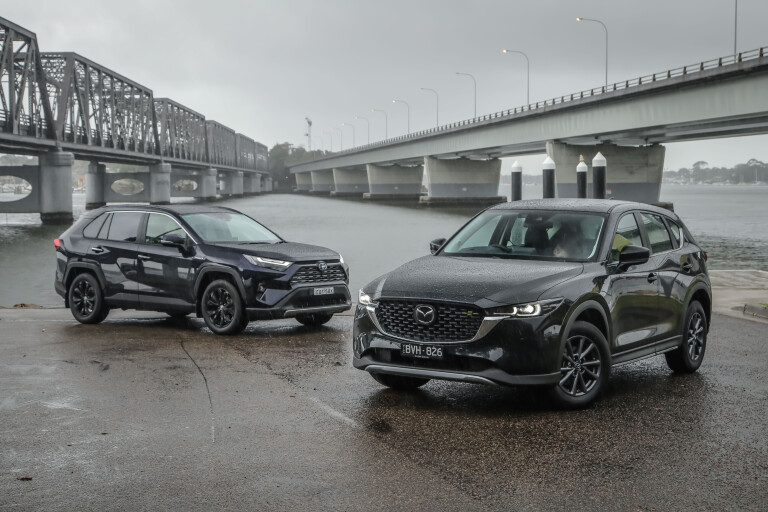
Mazda and Toyota have been battling each other for the mid-size SUV crown for almost a decade. For most of that decade, they traded blows in the sales race but the Mazda CX-5 was the better car. But then came the current generation of Toyota RAV4, with its TNGA underpinnings, a big lift in driver dynamics and an ever-improving hybrid drivetrain.
I often cheered the Mazda on for doing well because out of the mid-size SUV pack, it was the nicest of the lot to drive, occupy and look at.
Toyota changed the game overnight with a RAV4 that comprehensively obliterated criticisms of the previous generation, while a range of competitors have been inspired to do better by Mazda’s mid-sizer.
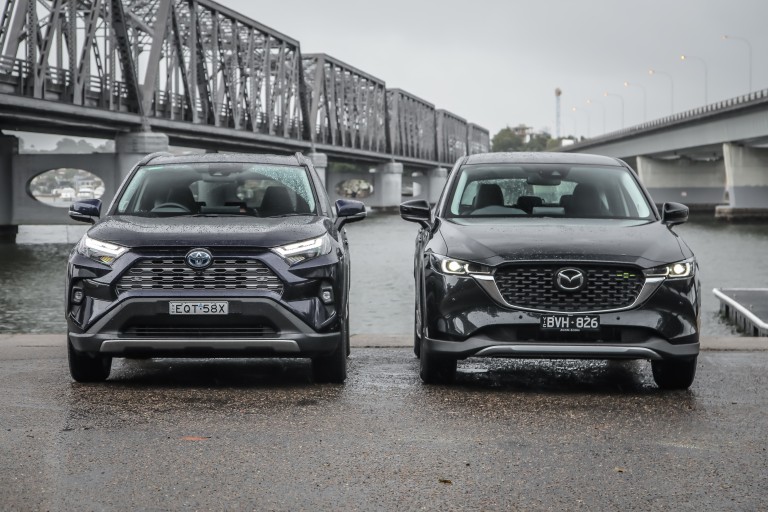
Mazda never takes a challenge lightly and is always tweaking, always hustling, looking for new ways to improve the CX-5 and its appeal. Drop an engine here, add a spec level there, listen to the customers, deliver on safety and driving dynamics then send it into battle.
Pricing and features
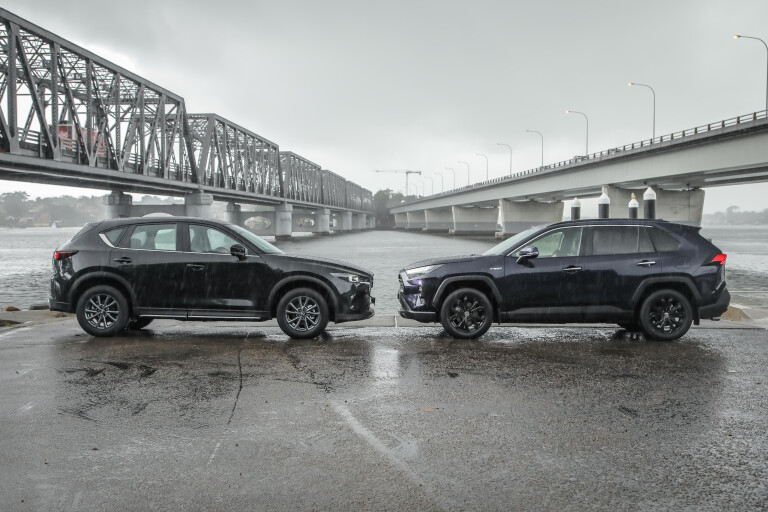
Mazda offers two Touring Actives, the 2.5-litre petrol at $42,880 and the 2.2-litre turbodiesel at $45,880 (before on-road costs), both of them in all-wheel-drive guise.
If you’re happy to save $500 to lose the Active’s hi-vis green, there is the Touring in petrol AWD format.
A CX-5 Touring Active ships with 17-inch alloys, dual-zone climate control, six-speaker stereo, reversing camera, cloth interior, keyless entry and start, front and rear parking sensors, adaptive cruise control, sat-nav, LED headlights with auto high beam, auto wipers, leather steering wheel and shifter, heated and folding rear vision mirrors, wireless phone charging and a space-saver spare.
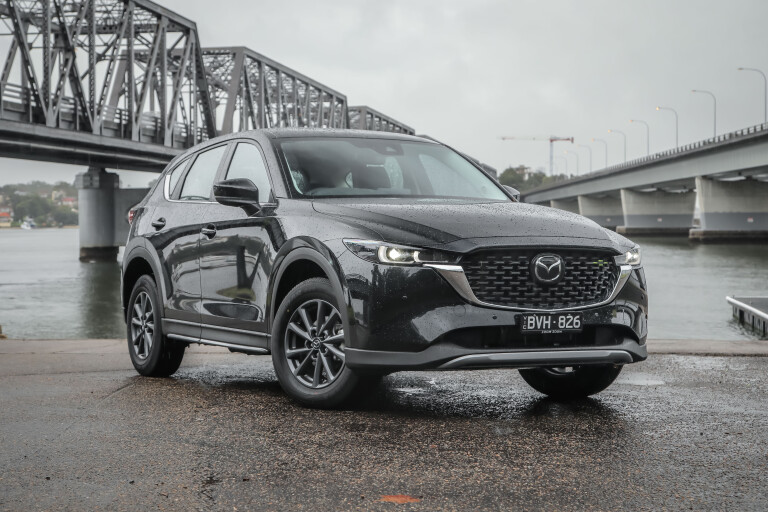
The Active adds a splash of lime green to the grille and takes the colour inside, replacing what is usually plastic or satin-finish chrome. The exterior also scores some extended plastic cladding where before there was painted sheetmetal, one of the things that makes the CX-5 a fine looker, so for me it’s a downside but for others, a boon.
In the cabin, you’ll find Mazda’s older version of MZD Connect and its 8.0-inch touchscreen with sat-nav plus USB connectivity for Apple CarPlay and Android Auto, which is fine and works well. This original version of MZD Connect has been around a while but it’s still light years away from Toyota’s galactically lazy approach to touchscreen media software.
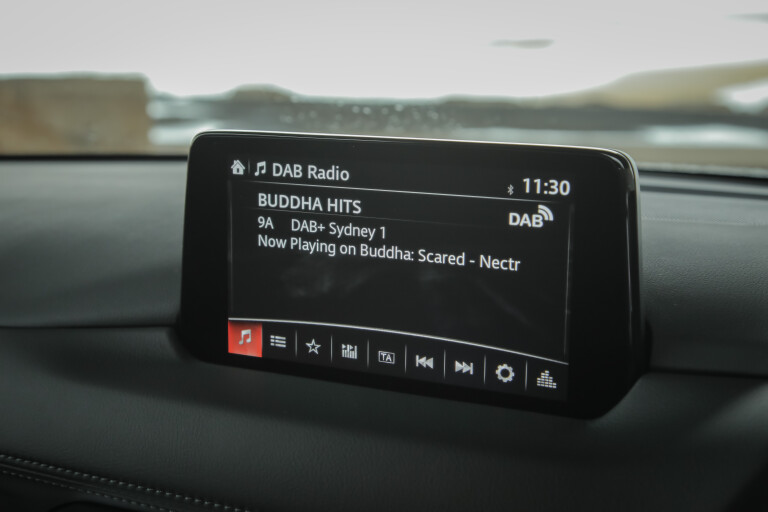
Mazda is hardly the biggest car company in the world and has its own software, but Toyota is the biggest car company in the world and should do better than what looks like something it just plucked off an open source file server somewhere.
For its part, the RAV4 Cruiser starts at $43,250 for the front-wheel-drive 2.0-litre version, jumping to $48,750 for the all-wheel-drive Cruiser Hybrid. In the middle, predictably, is the front-wheel-drive Cruiser Hybrid for $45,750.
Pitted against the $42,880 CX-5, this RAV4 looks pricey – until you remember it has an electric motor and battery pack to help you save fuel, as well as a few spec inclusions the Mazda is missing. Again all these prices are before on-road costs.
Infotainment: Toyota is the biggest car company in the world and should do better than what looks like something it just plucked off an open-source file server.
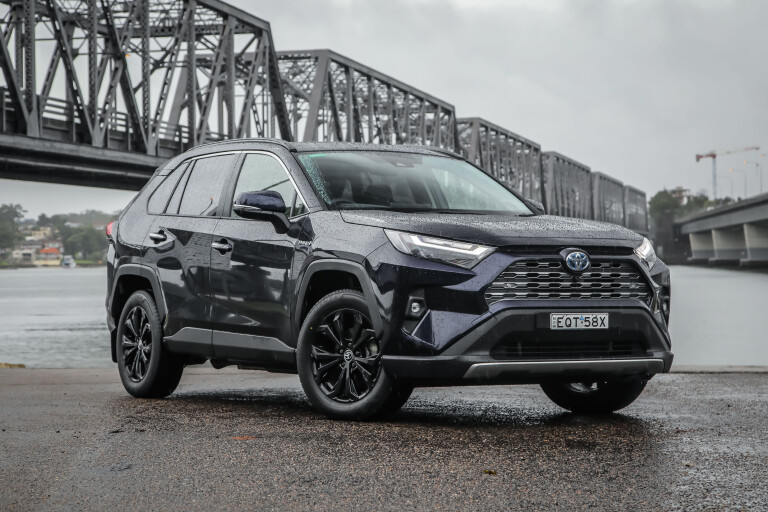
You get bigger 18-inch alloys, a nine-speaker stereo, dual-zone climate control, front and rear parking sensors, adaptive cruise control, keyless entry and start, 360-degree parking cameras, heated and ventilated front seats, sat-nav, auto LED headlights, auto wipers, powered tailgate, wireless phone charging and space-saver spare.
The Mazda’s five-star ANCAP score dates back to 2017 while the Toyota’s is from 2019. Neither feature a centre front airbag, which is a supposed pre-requisite for a 2022 five-star rating.
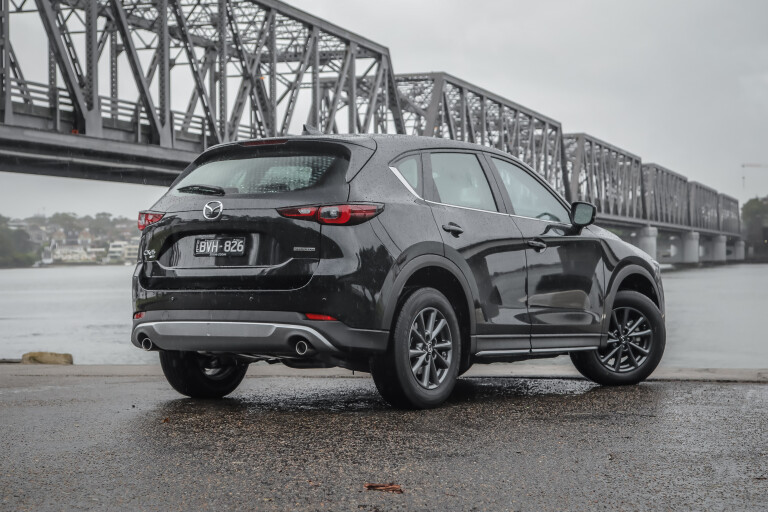
The Mazda has six airbags where the Toyota has seven (including driver’s knee airbag) but both have ABS, stability and traction controls, blind-spot monitoring, forward auto emergency braking (AEB), forward and rear collision warning, lane departure warning, lane-keep assist, speed limiter, speed zone reminder with road sign recognition and reverse cross-traffic alert.
On both, the forward AEB has pedestrian and cyclist detection while vehicle avoidance works at high and low speeds. The Mazda adds reverse AEB to just shade the Toyota on active safety whereas the RAV4 has that extra airbag for passive safety.
Either way, the Toyota does take the win on value as even though it’s more expensive in hybrid form, you’ll bridge some of the gap in total cost of ownership terms with fuel savings and the RAV just has more standard kit.
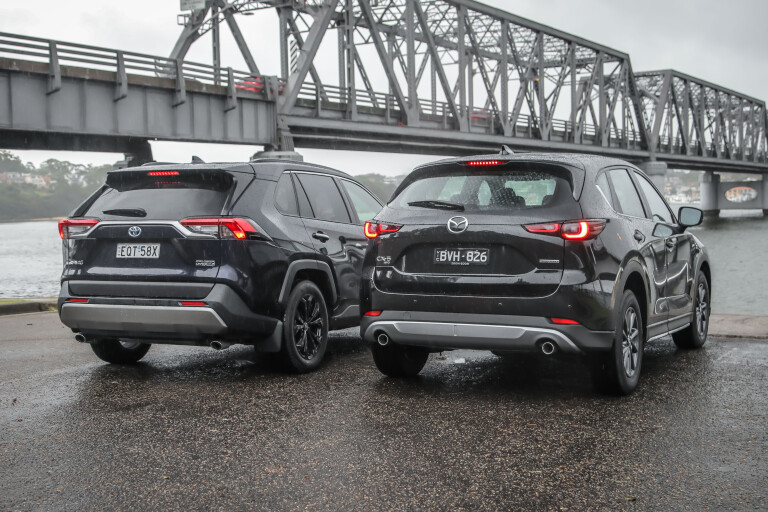
Comfort and space
It would be easy to say the RAV4 wins here purely on extra space because it has quite a bit of extra space, but it’s more than that – it’s useable space, with a much longer wheelbase handing you a lot of interior real estate.
Boot capacity in the CX-5 starts at 442 litres, soundly walloped by the RAV4’s 580 litres.
Annoyingly, Toyota fails to offer a figure with the rear seats down but it’s definitely more than the Mazda’s 1342 litres, at a guess by at least 200 litres. The RAV also has a powered tailgate to make access that little bit easier.
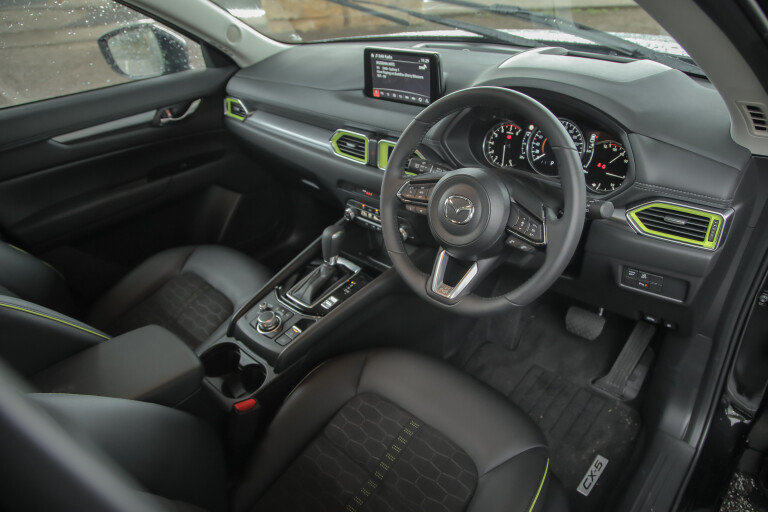
The Toyota stretches its advantage in rear seat accommodation. While both share pretty decent headroom, the RAV4 has more legroom and a more comfortable rear seat for longer journeys. The windows are also bigger, letting in more light and the rear door apertures are easier to pass through.
Both have good-sized bottle holders in the doors and a pair of cup holders in the centre armrest. And you get air vents in the rear as well as USB ports.
Moving to the front, the RAV4 again has more light and lighter-coloured materials to make the cabin feel bigger again. The CX-5’s is very pretty, with lovely materials and a calm, button-light design.
Mazda has slowly and deliberately gone through each of its interiors to reduce visual clutter but not at the expense of useability, pulling off an excellent balance.
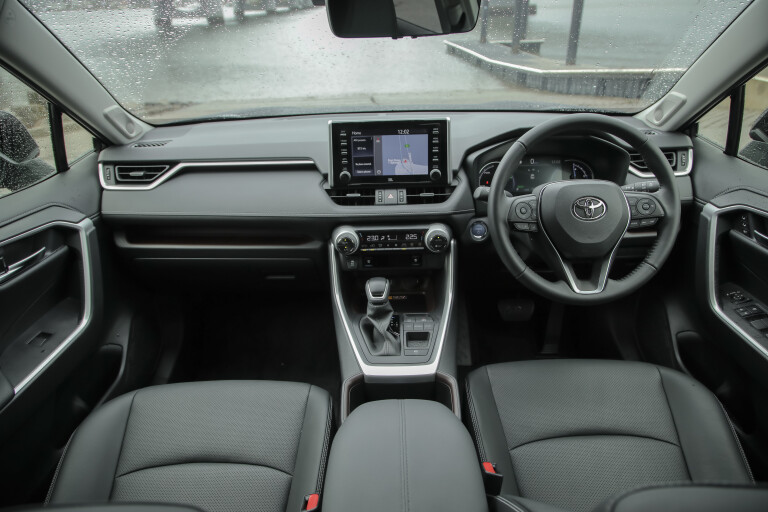
The RAV4 is a more, shall we say, family-ready interior, with slots and bins for stuff, rugged cloth on the seats and surfaces that look and feel like they’ll take a pounding.
I’ve long been a fan of the rubberised twist dials for the climate control, too, mostly because it’s unusual but it also sells the idea of a tough interior.
The Mazda wins on style – it’s the coolest by far – but the Toyota is roomier, slightly more comfortable in the back, and full of inventive storage ideas, so is the winner in every other area.
Mazda has slowly and deliberately gone through each of its interiors to reduce visual clutter but not at the expense of useability, pulling off an excellent balance.
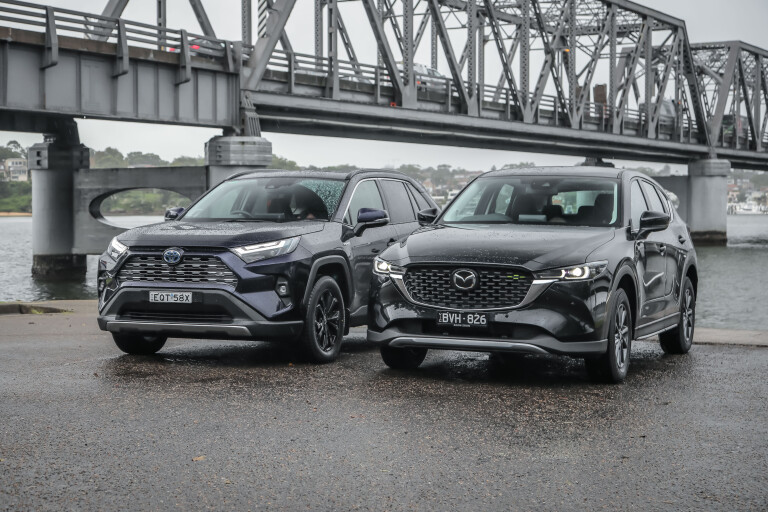
On the road
As you might expect, these two machines have very different drivetrains.
They’re not exactly matched – the Cruiser we had was front-wheel drive and the Mazda all-wheel drive, but you can chop and change each model around a bit to get a closer match. Either way, you either have to drop down to the Maxx Sport 2.0 on the Mazda for front-wheel drive or pay more for the RAV4’s eFour all-wheel-drive version.
Mazda still isn’t offering a true hybrid version of one of its most important cars.
The CX-5 has Mazda’s 2.5-litre naturally-aspirated four-cylinder with 140kW at 6000rpm and 252Nm at 4000rpm. Neither of those figures is startlingly high or depressingly low.

Mazda was one of the great proponents of stop-start tech to save fuel and has been working on improving fuel efficiency (rather than chasing power) and driveability for more than a decade. Power reaches all four wheels via Mazda’s own six-speed automatic.
Onboard the RAV4 you have a 131kW 2.5-litre four-cylinder, with 221Nm of torque.
When you add the electric motor, combined power rises to 160kW and while there is obviously a lot more torque, Toyota doesn’t quote a number, instead waving its hands in the air and mumbling about science and maths and stuff.
Suffice to say it’s going to be a solid chunk more than the Mazda’s twist number while there’s power in the battery.
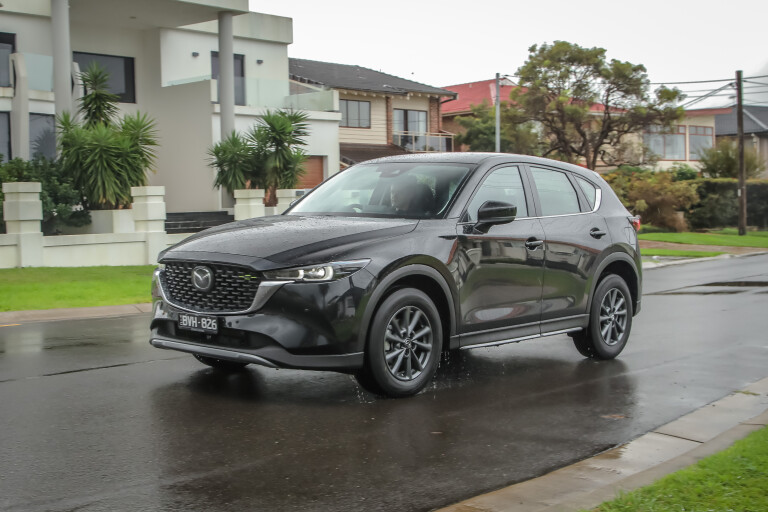
Fuel consumption
While the Mazda claims a combined cycle figure of 7.4L/100km, this isn’t really going to happen, with a fairly solid pattern of this engine and transmission combination delivering between 9.0 and 11.0L/100km.
The Toyota’s is 4.7L/100km and I’ve never got worse than 6.0L/100km, with the Cruiser’s dash telling me I’d used 5.6L/100km. When petrol is running at $2 per litre (June 2022), that’s a $6-$10 difference for every 100km.
The Mazda does its best with what it’s got. It’s quiet, refined and smooth and you can feel the years of work that has gone into this drivetrain. It’s not effortless but has enough power and torque to shift its 1659kg kerb weight around (the RAV4 is only 26kg heavier) with relative ease.
It’s almost a shame the turbo engine isn’t available in this spec, because it’s quite lovely.
On the freeway, it’s also very quiet and when the road becomes a bit more interesting, the CX-5’s decade of being the benchmark or a heartbeat away is clear. It has a lovely flowing feel when you’re moving around, the clever G-Vectoring chassis tech unobtrusively working in the background to help deliver a well-sorted, dynamic-for-an-SUV ride and handling balance.

The Mazda does its best with what it’s got. It’s quiet, refined and smooth and you can feel the years of work that has gone into this drivetrain.
Moving to the RAV4, owners of the old-gen may know that there was quite a gap between the CX-5 and RAV4’s driving experience. The old RAV was a bit of a duffer, noisy with hopeless steering and just not set up the way rivals were.
I could never bring myself to recommend a RAV4 because of the driving experience, but I can now cheerfully report that those particular demons have been banished.
This RAV rolls on a much newer platform and it shows. The hybrid drivetrain is exceptionally efficient and even in front-wheel-drive form you’ll get around smartly in town or on the freeway.
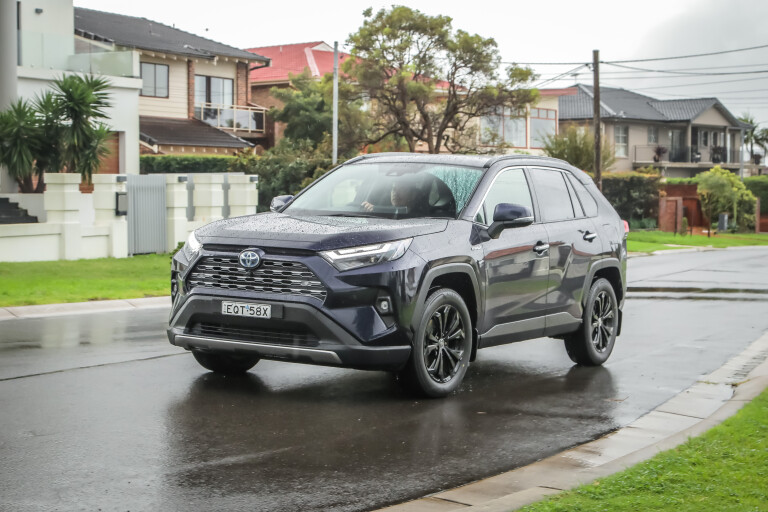
The automatic continuously variable transmission is probably its weakest point but is masked by the torque fill effect of the electric motor from standstill. It's still a decent transmission as far as the CVT style of transmissions goes.
The low-down pull of electric at very slow speeds and electric plus petrol at higher speeds is noticeably better than the Mazda’s more traditional set-up and may prove for some to be worth the price of admission alone.
The ride is good, even on the bigger 18-inch wheels and it has a much more positive steering and handling feel. It will lean over more than the CX-5 in cornering and is overall a softer set-up thanks largely to the rampantly sooky American market, but it does mean traversing potholes, lumpy roads and speed bumps is more comfortable.
The Mazda is more fun to drive and runs the RAV4 closely in other areas, but that hybrid driveline does, again, award the Toyota another win.

Ownership
Both companies offer a five-year warranty with unlimited kilometres and fixed price servicing regimes.
Once again, the Toyota takes a convincing win with the first five services costing $230 each for a total of $1150. You’ll return to the dealer every 12 months or 15,000km and keeping up with Toyota dealer servicing nets you an extra two years of warranty coverage on the drivetrain.
Mazda is still insisting on 12-month/10,000km service intervals. The capped-price servicing regime lasts for five services, with three priced at $350 and two at $380 for a total of $1810 over the five, costing an extra $660 over five services compared with the Toyota.
VERDICT
On cold hard facts, the Toyota RAV4 takes a pretty decent victory here.
From all objective angles, the RAV4 has it over the Mazda even though it does cost more to buy (and probably take longer to actually reach you).
The Mazda, to my eyes, is cooler and a slightly better car to drive, but these are only two things and not always the things buyers are looking for, or at least not at the top of the list.
The RAV4 uses less fuel, is cheaper to own and run, and justifies its pricing with a few extra bits and bobs in the cabin, the hybrid drivetrain, and more space for you and the family.
Neither is the wrong choice; both are terrific cars. The Mazda’s lack of hybrid tech just plays against it in this test, especially now with expensive fuel making that few bucks of difference every 100km even more important.
If the RAV had the Mazda’s looks and that little bit extra in the chassis, that is almost the perfect mid-size SUV right there.
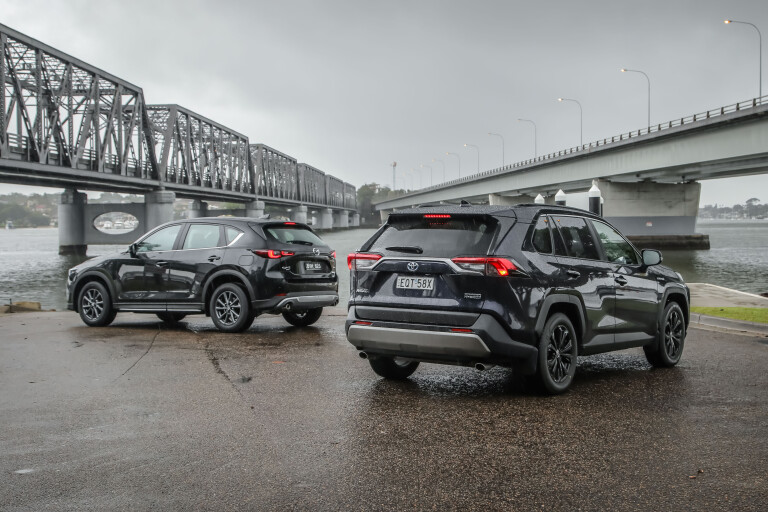
SCORING
Toyota RAV4 Cruiser Hybrid: 8.5/10
What we like
- Hybrid drivetrain
- Interior space
- Good ownership proposition
Not so much...
- Hopeless media system
- CVT gearbox
- Long wait times
Mazda CX-5 Touring Active score: 8.0/10
What we like
- Great looks
- Lovely to drive
- Premium, if dark, interior
Not so much...
- Short service intervals
- No turbo or hybrid option
- More expensive to service
2022 Mazda CX-5 vs Toyota RAV4 specification comparison
| Mazda CX-5 Touring Active 2.5 AWD | Toyota RAV4 Cruiser Hybrid 2WD | |
|---|---|---|
| Body: | 5-door, 5-seat medium SUV | 5-door, 5-seat medium SUV |
| Drive: | all-wheel | front-wheel |
| Engine: | 2.5-litre naturally-aspirated four-cylinder | 2.5-litre four-cylinder hybrid |
| Transmission: | 6-speed automatic | CVT with 10-speed auto mode |
| Power: | 140kW @ 6000rpm | 131kW @ 5700rpm |
| Torque: | 252Nm @ 4000rpm | 221Nm @ 3600-5200rpm |
| Combined power | NA | 160kW @ 5700rpm |
| Bore stroke (mm): | 89.0 x 100.0mm | 87.5 x 103.4 |
| Compression ratio: | 13.0 : 1.0 | 14.0 : 1.0 |
| 0-100km/h: | 9.7 sec (claimed) | 10 sec (estimate) |
| Fuel consumption: | 7.4L/100km (combined) | 4.7L/100km (combined) |
| Weight: | 1659kg | 1675kg |
| Suspension: | MacPherson strut front/multi-link rear | MacPherson struts front/multi-link rear |
| L/W/H: | 4550mm/1840mm/1675mm | 4600mm/1855mm/1685mm |
| Wheelbase: | 2700mm | 2906mm |
| Brakes: | 297mm ventilated disc front / 303mm solid disc rear | 305mm ventilated disc front / 281mm solid disc rear |
| Tyres: | 225/65 R17 | 225/60 R18 |
| Wheels: | 17-inch alloy (space-saver spare) | 18-inch alloy (space saver spare) |
| Price: | $42,880 + on-road costs | $45,750 + on-road costs |



COMMENTS